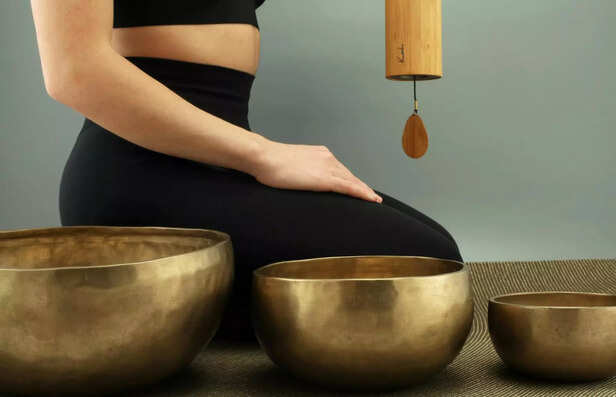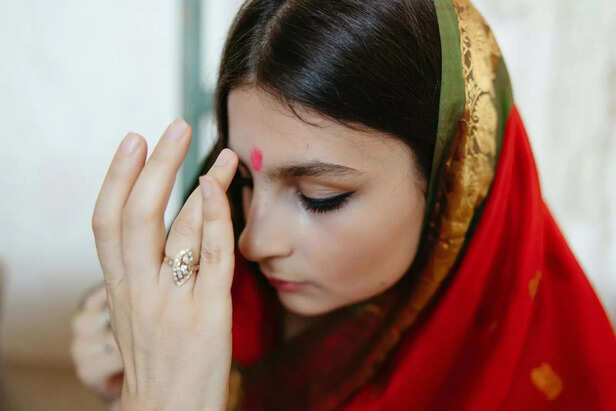Why Women Wear Bindi: Not Just Tradition, It Impacts the Brain
Riya Kumari | Jun 26, 2025, 12:44 IST
( Image credit : Timeslife )
Now, I used to think the bindi was just one of those things—like weddings on Wednesdays or putting haldi on your entire body for “glow”—that we did because, well, we’ve always done them. But as it turns out? That tiny dot isn’t just a fashion flex or a cultural nod. It’s… are you ready for this? Brain science. Literal neurostimulation. And suddenly I feel like the bindi deserves its own TED Talk.
There are some things we inherit before we understand them. The smell of incense before dawn. The rustle of a cotton sari brushing the floor. And the small, precise dot at the center of the forehead—the bindi. For many women, it was first pressed onto their forehead before they knew how to speak. It was put there by a mother, or a grandmother, or a priest with hands older than logic. And so it became something we wore. Something we didn’t question. A habit disguised as heritage. But habits hold histories. And some of them, like the bindi, hold far more than that—they hold intention.
The Point of the Dot

That spot between your eyebrows? It’s not arbitrary. In yogic and tantric sciences, it’s called the Ajna Chakra. In modern physiology, it overlaps with what’s known as the pineal gland—a small, light-sensitive part of the brain linked to intuition, regulation of sleep, and inner clarity. But even without words like “chakra” or “gland,” women always knew this was a powerful place. They touched it during prayer. They cooled it with sandal paste in summer. They adorned it with sindoor, kumkum, ash, or turmeric—not for appearance, but for alignment.
Because the bindi wasn’t made for the world to see you. It was made for you to see yourself—clearly.
The Wisdom of Placement

We often forget: our ancestors didn’t do anything without meaning. In a world without noise, what they practiced was presence. The bindi is a mark of that presence. Placed at the center of the forehead, it was meant to still the mind. To bring attention inward. To quiet the scattered chatter of the day and focus it into one sharp, unwavering point. It said: Return to center. Don’t forget who you are. And isn’t that what so many women struggle with today? Losing the center in the chaos. Being pulled in a hundred directions but never pausing long enough to ask: Where am I in all this?
The bindi answers that. Quietly. Without needing to.
From Silence, Power

The beauty of the bindi is in what it doesn’t scream. It doesn’t need to prove anything. It just is. It sits in stillness. And yet it’s one of the oldest symbols of feminine power. It represents not just marriage or tradition, but presence, awareness, anchoring. It was never meant to be ornamental. It was always functional—spiritually, emotionally, energetically. The woman who wears it is saying: I remember something the world wants me to forget. That I am not just a body moving through expectation.
I am a mind that sees. I am a spirit that centers. And I am more than what meets the eye.
More Than Aesthetics

Yes, bindis have become fashionable. And yes, they can be worn by anyone, styled in a hundred different ways. That’s the beauty of living tradition—it evolves. But evolution without understanding is dilution. When a thing becomes only “cool,” it begins to lose its root.
The bindi isn’t just a dot. It is direction. A reminder that there is a center inside of us that cannot be moved by what trends, what changes, or what fades.
A Final Thought
In a world that keeps asking women to be louder, brighter, more visible, the bindi asks her to do the opposite. It asks her to go inward. To be still. To listen. To know. That’s not decoration. That’s wisdom.
And it’s time we returned to it—not because it’s tradition, but because it’s true.
The Point of the Dot

Meditate
( Image credit : Pexels )
That spot between your eyebrows? It’s not arbitrary. In yogic and tantric sciences, it’s called the Ajna Chakra. In modern physiology, it overlaps with what’s known as the pineal gland—a small, light-sensitive part of the brain linked to intuition, regulation of sleep, and inner clarity. But even without words like “chakra” or “gland,” women always knew this was a powerful place. They touched it during prayer. They cooled it with sandal paste in summer. They adorned it with sindoor, kumkum, ash, or turmeric—not for appearance, but for alignment.
Because the bindi wasn’t made for the world to see you. It was made for you to see yourself—clearly.
The Wisdom of Placement

Bindi
( Image credit : Pexels )
We often forget: our ancestors didn’t do anything without meaning. In a world without noise, what they practiced was presence. The bindi is a mark of that presence. Placed at the center of the forehead, it was meant to still the mind. To bring attention inward. To quiet the scattered chatter of the day and focus it into one sharp, unwavering point. It said: Return to center. Don’t forget who you are. And isn’t that what so many women struggle with today? Losing the center in the chaos. Being pulled in a hundred directions but never pausing long enough to ask: Where am I in all this?
The bindi answers that. Quietly. Without needing to.
From Silence, Power

Shringar
( Image credit : Pexels )
The beauty of the bindi is in what it doesn’t scream. It doesn’t need to prove anything. It just is. It sits in stillness. And yet it’s one of the oldest symbols of feminine power. It represents not just marriage or tradition, but presence, awareness, anchoring. It was never meant to be ornamental. It was always functional—spiritually, emotionally, energetically. The woman who wears it is saying: I remember something the world wants me to forget. That I am not just a body moving through expectation.
I am a mind that sees. I am a spirit that centers. And I am more than what meets the eye.
More Than Aesthetics

Bride
( Image credit : Pexels )
Yes, bindis have become fashionable. And yes, they can be worn by anyone, styled in a hundred different ways. That’s the beauty of living tradition—it evolves. But evolution without understanding is dilution. When a thing becomes only “cool,” it begins to lose its root.
The bindi isn’t just a dot. It is direction. A reminder that there is a center inside of us that cannot be moved by what trends, what changes, or what fades.
A Final Thought
And it’s time we returned to it—not because it’s tradition, but because it’s true.
